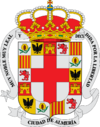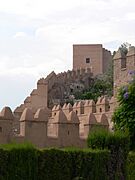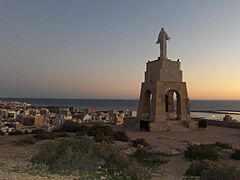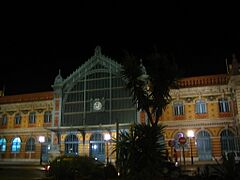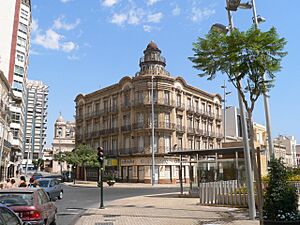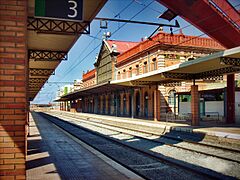Almería facts for kids
Quick facts for kids
Almería
|
|||
|---|---|---|---|
|
|||
| Motto(s):
"Muy noble, muy leal y decidida por la libertad: ciudad de Almería"
(Very noble, very loyal and determined towards freedom: city of Almería) |
|||
| Country | |||
| Region | |||
| Province | Almería | ||
| Comarca | Comarca Metropolitana de Almería | ||
| Founded | 955 | ||
| Founded by | Abd-ar-Rahman III | ||
| Government | |||
| • Body | Ayuntamiento de Almería | ||
| Area | |||
| • Total | 12.36 km2 (4.77 sq mi) | ||
| Elevation | 24 m (79 ft) | ||
| Highest elevation
(Peak Pico Colativí)
|
1,387 m (4,551 ft) | ||
| Lowest elevation | 0 m (0 ft) | ||
| Population
(2018)
|
|||
| • Total | 196,851 | ||
| • Density | 15,926/km2 (41,249/sq mi) | ||
| Demonyms | almerienses, urcitanos | ||
| Time zone | UTC+1 (CET) | ||
| • Summer (DST) | UTC+2 (CEST) | ||
| Postal code |
04001-04090
|
||
| Area code(s) | (+34) 950 | ||
| Vehicle registration | AL | ||
| Website | http://www.aytoalmeria.es | ||
Almería is a city and municipality in Spain, located in Andalusia. It is the capital of the province of the same name. The city is in southeastern Iberia right by the Mediterranean Sea. Caliph Abd al-Rahman III founded the city in the year 955. Almería became very rich during the Islamic era, growing into an important city in the 11th and 12th centuries. It had a busy port where people traded silk, oil, and raisins. Because it's next to a small desert, Almería has a very dry climate compared to other places in Europe.
Contents
What's in a Name?
The name "Almería" comes from its old Arabic name, Madīnat al-Mariyya. This means "city of the watchtower". It was first known as Mariyyat al-Bajjāna because it was the port for a nearby town called Pechina.
Almería's Story Through Time
Almería's story began in the 9th century as a small trading port for a place called Pechina. Over time, Almería grew more important than Pechina. In 955, a ruler named Abd-ar-Rahman III decided to build strong walls around the city.
Almería became famous for its silk industry. Hundreds of looms made silk from mulberry trees grown in the area. After the main government in Córdoba fell apart in the early 11th century, Almería became an independent state called a taifa. It was ruled by different kings until 1091.
During the 11th and 12th centuries, Almería was one of the biggest cities in Al-Andalus (Muslim Spain). It traded indigo dye and wool from North Africa and linen from Egypt. It also sent copper and its special textiles to other cities.
In 1147, Christian armies, led by Alfonso VII, attacked and captured Almería. This ended the city's golden age in the Middle Ages. But in 1157, Muslim Almohad rulers took control again.
Later, Almería became part of the Emirate of Granada in 1238. It remained an important port for trade and a safe place for ships. In 1309, the city faced a tough attack from armies from Aragon, but it survived.
On December 22, 1489, Almería became part of the lands ruled by the Catholic Monarchs of Spain. The 16th century was hard for Almería. There were several earthquakes, with a very strong one in 1522 that badly damaged the city. Also, Barbary pirates often attacked the coast until the early 18th century.
Later, large iron mines were found. French and British companies came to the area, bringing new wealth and making Almería important again.

During the Spanish Civil War, the German Navy attacked the city. Almería was the last major city in Andalusia to be taken by Franco's forces in 1939.
In the second half of the 20th century, Almería grew a lot thanks to tourism and farming. Huge plastic-covered "greenhouses" called invernaderos grow vegetables all year round.
After Franco's death, the people of southern Spain voted to become an independent region called Andalusia. Almería province voted strongly in favor of this.
Cool Places to See
- The Alcazaba: This is a huge medieval fortress that started being built in the 10th century. An earthquake damaged it in 1522, but it's still amazing. It has three lines of walls, a grand keep, and beautiful gardens. It's the second largest Muslim fortress in Andalusia, after the Alhambra.
- Almería Air Raid Shelters: These are underground tunnels built to protect people during the Spanish Civil War. They are the longest in Europe that you can visit today!
- The Cathedral: This church looks like a fortress with its towers and strong walls. This was to protect it from pirates. It was rebuilt in the 16th century after the 1522 earthquake.
- Renaissance Church of Santiago: Built in 1533, this church has a tower and entrance decorated with cool carvings.
- Chanca: A unique group of houses carved right into the rocks.
- Castle of San Cristobal: Now in ruins, this castle is connected to the Alcazaba by a line of walls.
- Museum of Almería: Here you can see amazing things found from ancient times, including objects from the Alcazaba.
- Paseo de Coches: A modern walkway by the sea with gardens and palm trees.
- Cable Inglés (English Pier): This iron pier was built in 1904 to load iron ore, copper, and silver from trains onto ships.
How Many People Live Here?
| 1999 | 2001 | 2003 | 2005 | 2007 | 2009 | 2011 | 2012 | 2013 | 2014 | 2017 | 2018 | 2019 | 2020 |
|---|---|---|---|---|---|---|---|---|---|---|---|---|---|
| 169,027 | 170,994 | 176,727 | 181,702 | 189,798 | 188,810 | 190,349 | 191,443 | 192,697 | 193,251 | 195,389 | 196,851 | 198,533 | 201,322 |
People and Fun Facts
Many famous people come from Almería!
- Nicolás Salmerón y Alonso was the third president of the First Spanish Republic in 1873.
- Musicians like José Padilla Sánchez, whose music is famous worldwide, and popular folk singer Manolo Escobar.
- The amazing Flamenco guitar player José Tomás "Tomatito" and Grammy Award winner David Bisbal are also from here.
- Champion motorcyclist Antonio Maeso moved to Almería when he was a kid.
The Irish band The Pogues even sang about Almería in their song "Fiesta"! The electronic band Depeche Mode filmed their "Personal Jesus" music video in Almería in 1989.
Tourism in Almería got a big boost when parts of the TV series Game of Thrones were filmed there for its sixth season.
Sports in Almería
Almería hosted the Mediterranean Games in 2005, which is a big sports event. The city has two football (soccer) teams: UD Almería, which plays in Spain's top league, La Liga, and CP Almería.
The Plaza de toros de Almería is the city's main bullring. It can hold 10,000 people and opened in 1882.
Movies Made Here
How Almería Makes Money
For the last 50 years, farming has been the most important way Almería makes money. Growing vegetables in huge plastic-covered "greenhouses" (invernaderos) makes up almost 40% of Almería's total income.
This farming success comes from always using new technologies. Things like special soil, plastic covers, and drip irrigation help improve how much food is grown. They also make sure the crops are good quality and can be sold all year. Almería sends a lot of its produce abroad. In 2018, 75% of what was grown was sold to other countries, bringing in a lot of money.
Many farms in Almería are family-owned and small. This helps create a fair income level and good living conditions for many people. Farmers in Almería are also well-educated and always learning new ways to farm. Many businesses in this area are run as cooperative societies. These companies help farmers sell their products and get advice.
Getting Around Almería
You can reach Almería by land using the A-7 Mediterranean Highway. The Almería railway station has train services to Granada and Madrid. Soon, high-speed rail services will connect Almería to Madrid even faster.
By sea, the Port of Almería has connections to cities like Melilla, Algeria, and Morocco. It also welcomes tourist cruises. The port is growing with new docks to handle more international shipping.
- Acciona: Connects to Ghazaouet (Algeria), Oran (Algeria), Nador (Morocco) and Melilla.
- Comarit: Connects to Nador.
- Comanav: Connects to Nador.
By air, Almería Airport is the fourth largest in Andalusia. You can fly to cities like Madrid, Barcelona, Melilla, London, and Seville. During summer, there are more international flights to places like Manchester, Birmingham, Brussels, and Dublin.
Almería's Landscape
Almería has a very dry landscape, which made it a popular spot for filming "Spaghetti Western" movies. Some of these old movie sets are still there and you can visit them in the desert of Tabernas. Famous movies like Lawrence of Arabia (1962) and The Wind and the Lion (1975) were filmed here.
One of Almería's most beautiful natural places is the Cabo de Gata-Níjar Natural Park. This park was formed by volcanoes and is the biggest and most important marine and land area in the western Mediterranean Sea. The villages in the park, once known for fishing, are now popular tourist spots. The beaches of Cabo de Gata-Níjar Natural Park are also a big draw.
Almería also manages a small island called Alboran Island in the Alboran Sea. It has a small cemetery, a harbor, and a lighthouse built in the 1800s.
Weather in Almería
Almería has a very dry climate, almost like a desert. It is the driest city in Europe and one of the sunniest, with about 3,000 hours of sunshine and over 320 sunny days each year!
It's interesting to know that Almería is the only city in Continental Europe that has never recorded a temperature below freezing (0°C or 32°F) in its history. The coldest it has ever been was just 0.1°C (32.2°F). Snow is extremely rare here.
In winter, daily temperatures are usually around 17-18°C (63-64°F), and at night they stay around 8-10°C (46-50°F). This makes Almería one of the warmest cities in Spain during winter. It only gets about 200 mm (8 inches) of rain each year, spread over about 26 days.
In summer, the skies are usually sunny with almost no rain. Daily temperatures are around 30°C (86°F), and at night they stay around 22°C (72°F) in July and August. The hottest temperature ever recorded was 42.0°C (107.6°F) in August 2022.
| Month | Jan | Feb | Mar | Apr | May | Jun | Jul | Aug | Sep | Oct | Nov | Dec | Year |
|---|---|---|---|---|---|---|---|---|---|---|---|---|---|
| Record high °C (°F) | 25.7 (78.3) |
27.0 (80.6) |
32.4 (90.3) |
30.6 (87.1) |
36.3 (97.3) |
40.8 (105.4) |
41.6 (106.9) |
42.0 (107.6) |
38.4 (101.1) |
34.5 (94.1) |
29.0 (84.2) |
27.7 (81.9) |
42.0 (107.6) |
| Mean daily maximum °C (°F) | 17.0 (62.6) |
17.6 (63.7) |
19.4 (66.9) |
21.3 (70.3) |
24.3 (75.7) |
27.8 (82.0) |
30.5 (86.9) |
31.2 (88.2) |
28.2 (82.8) |
24.5 (76.1) |
20.3 (68.5) |
17.9 (64.2) |
23.3 (74.0) |
| Daily mean °C (°F) | 12.8 (55.0) |
13.4 (56.1) |
15.1 (59.2) |
17.1 (62.8) |
20.1 (68.2) |
23.6 (74.5) |
26.4 (79.5) |
27.2 (81.0) |
24.2 (75.6) |
20.6 (69.1) |
16.3 (61.3) |
13.9 (57.0) |
19.2 (66.6) |
| Mean daily minimum °C (°F) | 8.7 (47.7) |
9.2 (48.6) |
10.9 (51.6) |
12.9 (55.2) |
15.8 (60.4) |
19.3 (66.7) |
22.2 (72.0) |
23.1 (73.6) |
20.2 (68.4) |
16.6 (61.9) |
12.3 (54.1) |
9.8 (49.6) |
15.1 (59.2) |
| Record low °C (°F) | 0.1 (32.2) |
1.0 (33.8) |
1.0 (33.8) |
6.0 (42.8) |
8.4 (47.1) |
10.4 (50.7) |
12.0 (53.6) |
14.8 (58.6) |
10.1 (50.2) |
3.4 (38.1) |
3.1 (37.6) |
2.0 (35.6) |
0.1 (32.2) |
| Average precipitation mm (inches) | 20.8 (0.82) |
23.3 (0.92) |
20.7 (0.81) |
15.2 (0.60) |
10.9 (0.43) |
5.5 (0.22) |
0.6 (0.02) |
2.3 (0.09) |
16.1 (0.63) |
25.2 (0.99) |
25.1 (0.99) |
31.8 (1.25) |
197.5 (7.77) |
| Average precipitation days (≥ 1 mm) | 2.7 | 2.7 | 3.1 | 2.6 | 1.6 | 0.6 | 0.2 | 0.3 | 1.9 | 3.1 | 3.2 | 3.0 | 25 |
| Mean monthly sunshine hours | 195.2 | 198.2 | 239.3 | 267.5 | 306.2 | 335.0 | 353.5 | 326.8 | 261.2 | 224.9 | 191.2 | 184.7 | 3,083.7 |
| Source 1: Agencia Estatal de Meteorologia (AEMET OpenData) for temperatures and precipitation | |||||||||||||
| Source 2: NOAA for precipitation days and sunshine | |||||||||||||
| Month | Jan | Feb | Mar | Apr | May | Jun | Jul | Aug | Sep | Oct | Nov | Dec | Year |
|---|---|---|---|---|---|---|---|---|---|---|---|---|---|
| Record high °C (°F) | 25.7 (78.3) |
27.0 (80.6) |
32.4 (90.3) |
30.6 (87.1) |
36.3 (97.3) |
40.8 (105.4) |
41.6 (106.9) |
42.0 (107.6) |
38.4 (101.1) |
34.5 (94.1) |
29.0 (84.2) |
27.7 (81.9) |
42.0 (107.6) |
| Mean daily maximum °C (°F) | 16.9 (62.4) |
17.6 (63.7) |
19.6 (67.3) |
21.4 (70.5) |
24.1 (75.4) |
27.9 (82.2) |
30.5 (86.9) |
31.0 (87.8) |
28.4 (83.1) |
24.5 (76.1) |
20.5 (68.9) |
17.9 (64.2) |
23.4 (74.0) |
| Daily mean °C (°F) | 12.6 (54.7) |
13.3 (55.9) |
15.1 (59.2) |
17.0 (62.6) |
19.7 (67.5) |
23.5 (74.3) |
26.1 (79.0) |
26.7 (80.1) |
24.2 (75.6) |
20.4 (68.7) |
16.4 (61.5) |
13.8 (56.8) |
19.1 (66.4) |
| Mean daily minimum °C (°F) | 8.3 (46.9) |
9.0 (48.2) |
10.6 (51.1) |
12.5 (54.5) |
15.3 (59.5) |
18.9 (66.0) |
21.7 (71.1) |
22.4 (72.3) |
20.0 (68.0) |
16.3 (61.3) |
12.3 (54.1) |
9.6 (49.3) |
14.7 (58.5) |
| Record low °C (°F) | 0.1 (32.2) |
1.0 (33.8) |
1.0 (33.8) |
6.0 (42.8) |
8.4 (47.1) |
10.4 (50.7) |
12.0 (53.6) |
14.8 (58.6) |
10.1 (50.2) |
3.4 (38.1) |
3.1 (37.6) |
2.0 (35.6) |
0.1 (32.2) |
| Average precipitation mm (inches) | 24 (0.9) |
25 (1.0) |
16 (0.6) |
17 (0.7) |
12 (0.5) |
5 (0.2) |
1 (0.0) |
1 (0.0) |
14 (0.6) |
27 (1.1) |
28 (1.1) |
30 (1.2) |
200 (7.9) |
| Average precipitation days (≥ 1 mm) | 2.9 | 2.9 | 2.6 | 2.6 | 1.9 | 0.6 | 0.3 | 0.3 | 1.5 | 2.8 | 3.6 | 3.3 | 25.4 |
| Average relative humidity (%) | 67 | 67 | 65 | 62 | 63 | 61 | 60 | 63 | 65 | 68 | 67 | 67 | 65 |
| Average dew point °C (°F) | 7 (45) |
7 (45) |
9 (48) |
10 (50) |
13 (55) |
16 (61) |
18 (64) |
20 (68) |
18 (64) |
15 (59) |
10 (50) |
8 (46) |
13 (55) |
| Mean monthly sunshine hours | 194 | 191 | 232 | 261 | 297 | 325 | 342 | 315 | 256 | 218 | 183 | 178 | 2,994 |
| Mean daily daylight hours | 10.5 | 11.3 | 12.4 | 13.6 | 14.6 | 15.2 | 14.9 | 14 | 12.8 | 11.7 | 10.7 | 10.2 | 12.7 |
| Source 1: Agencia Estatal de Meteorología | |||||||||||||
| Source 2: Time and Date (dewpoints, between 1985−2015) Weatherbase(length of day) | |||||||||||||
Giant Crystal Cave
In 2000, geologists found an amazing cave near Almería. It was filled with giant gypsum crystals! This cave, which is about 8 meters long, 1.8 meters wide, and 1.7 meters high, might be the biggest geode ever found. The cave was formed about 6 million years ago when the Mediterranean Sea dried up, leaving thick layers of salt. You can now visit this incredible site on guided tours.
Fun Festivals
Almería has many exciting events throughout the year:
- Carnival
- Holy Week
- Cruces de mayo (May Crosses)
- Saint Joan's Eve
Famous People from Almería
- Said al-Andalusi (1029–1070), a smart mathematician, astronomer, and philosopher.
- José Tomás "Tomatito" (born 1958), a famous flamenco guitar player.
- Lita Baron (1923–2015), an actress, singer, and dancer.
- David Bisbal (born 1979), a Grammy Award winner.
- Francisco Losada (1612–1667), a composer.
- Nieves Navarro (born 1938), an actress.
- Manuel Lao Hernández, who started Cirsa, Spain's biggest casino company.
- Rosa García-Malea López (born 1981), the first female fighter pilot in the Spanish Air Force.
- Juan Martínez Oliver (born 1964), a road bicycle racer.
- Eduardo del Pino Vicente, a journalist and writer.
- Chus Lampreave (1930–2016), an actress who passed away in Almería.
- Jimena Quirós (1899–1983), a Spanish scientist and the first female oceanographer in the country.
See also
 In Spanish: Almería para niños
In Spanish: Almería para niños








